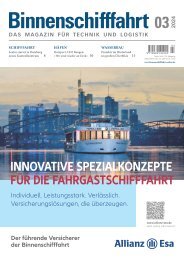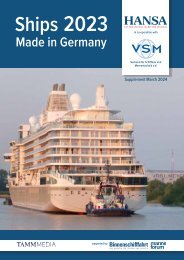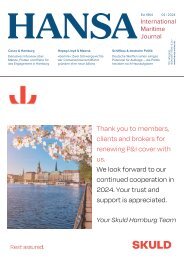HANSA - International Maritime Journal, November 2018
HANSA - International Maritime Journal, November 2018
HANSA - International Maritime Journal, November 2018
Erfolgreiche ePaper selbst erstellen
Machen Sie aus Ihren PDF Publikationen ein blätterbares Flipbook mit unserer einzigartigen Google optimierten e-Paper Software.
Schiffstechnik | Ship Technology<br />
14 months to go<br />
Photo: Selzer<br />
The IMO’s decision to implement the 0.50 % sulphur limit for marine fuels on ships<br />
operating outside sulphur emissions control areas (ECA-SOx) from 1 January 2020 has the<br />
industry scrambling for solutions. After an initial period of scepticism and doubt, the<br />
debate has firmly turned towards the transition and implementation planning for 2020<br />
Various market surveys indicate that<br />
most shipowners and operators intend<br />
to comply with the MARPOL Annex<br />
VI regulation 14.1.3 by burning 0.50%<br />
Very Low Sulphur Fuel Oils (VLSFOs).<br />
As a member of various industry forums,<br />
LR’s FOBAS (Fuel Oil Bunker Analysis &<br />
Advisory Service) team is actively participating<br />
in these discussions to help guide<br />
the industry by carefully considering operators<br />
requirements and concerns.<br />
Refiners and suppliers<br />
Refineries, storage depots and physical<br />
suppliers will have to contend with over<br />
150 mill. t of high sulphur residual fuel oil<br />
becoming surplus to demand from 1 January<br />
2020, being replaced by the demand<br />
for maximum 0.5% VLSFO.<br />
Refiners are faced with difficult decision<br />
to make multimillion pound longterm<br />
investment for bottom upgrading,<br />
source sweet crude or look for other outlets<br />
of high sulphur residual fuels after<br />
January 2020 when this convenient marine<br />
bunker option is no longer available.<br />
Some refineries have made a decision to<br />
invest in coking plants. However, there<br />
are others who may be playing a waiting<br />
game to see how the exhaust gas scrubber<br />
market evolves. The IMO fuel availability<br />
study predicted that around 3,800 ships<br />
with Exhaust Gas Cleaning systems<br />
(EGCS) will be in use by the implementation<br />
date; however, so far the projected<br />
numbers are more in the region of 1,500-<br />
2,000 units or ships. Considering almost<br />
fifty thousand ocean-going vessels will<br />
be affected, the aforementioned number<br />
appears not significant enough to have a<br />
major impact on global high sulphur fuel<br />
oil (HSFO) demand from 2020.<br />
Nonetheless, in view of expected greater<br />
price differential between HSFO and<br />
0.5% VLSFO by 2020, shipowners and<br />
operators have shown increased interest<br />
in EGCS installations yet there are a<br />
number of operational, logistical, technical,<br />
regulatory and commercial parameters<br />
requiring careful consideration,<br />
making it a complex decision-making<br />
process. LR has developed an options<br />
evaluator to help clients make an informed<br />
decision based on the specific operational<br />
profile of vessels.<br />
To help the supply chain, we also emphasise<br />
to ship operators that they open<br />
dialogue with their charterers and suppliers<br />
and place their interest in the type<br />
of fuel they will need, based on ship operations<br />
and trading pattern, so that<br />
suppliers also get themselves prepared<br />
to meet the demand ahead of 1 January<br />
2020 deadline.<br />
An update from the IMO<br />
MEPC 73 is scheduled in a week’s time<br />
(22-26 October) where S2020 will be a<br />
main discussion point. It is expected that<br />
the final draft on the carriage ban of high<br />
sulphur fuels (unless a ship is fitted with<br />
an EGCS) is expected to be adopted with<br />
the convention, eventually coming into<br />
force on 1 March 2020. It is also expected<br />
that at this meeting, the Ship Implementation<br />
Plan (SIP) for consistent implementation<br />
will be discussed including<br />
the guidelines for Port State Control.<br />
A Joint Industry Project (JIP) working<br />
group has been tasked to develop »Joint<br />
industry guidance on potential safety<br />
and operational issues related to the supply<br />
and use of 0.5% max Sulphur fuels«.<br />
It is expected that a draft of this comprehensive<br />
guidance document will be submitted<br />
to PPR6 (Pollution prevention and<br />
Response – An IMO sub-committee) in<br />
February 2019.<br />
54 <strong>HANSA</strong> <strong>International</strong> <strong>Maritime</strong> <strong>Journal</strong> – 155. Jahrgang – <strong>2018</strong> – Nr. 11


















